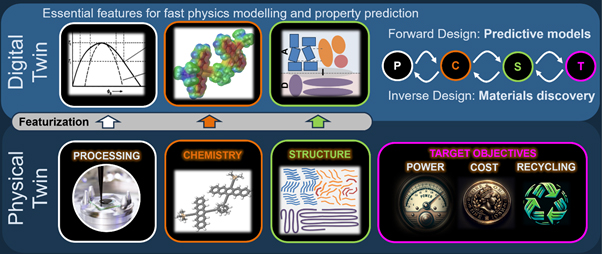Lüer L., Peters I.M., Smith A.S., Dorschky E., Eskofier B., Liers-Bergmann F., Franke J., Sjarov M., Brossog M., Guldi D.M., Maier A., Brabec C.J.
Joule 8 (2024), 1-17
The recent successes of emerging photovoltaics (PVs) are largely driven by innovations in material science. However, closing the gap to commercialization still requires significant progress to match contradicting requirements, such as performance, longevity, and recyclability. In this perspective, we envision the layout of a digital twin for PV materials able to provide the necessary acceleration of innovation.
The layout combines machine learning approaches, as performed in materials acceleration platforms (MAPs), with physical models and digital twin concepts used in engineering. This layout will allow the use of high-throughput (HT) experimentation in MAPs to improve the parametrization of quantum chemical and solid-state models. In turn, the improved and generalized models can be used to obtain the crucial structural parameters. HT experimentation will thus yield a detailed understanding of generally valid structure-property relationships. We discuss the current state of the enabling technologies, namely fast scale-bridging surrogate models and large-scale optimization under uncertainty, and identify promising approaches for further development.

Lüer L., Peters I.M., Smith A.S., Dorschky E., Eskofier B., Liers-Bergmann F., Franke J., Sjarov M., Brossog M., Guldi D.M., Maier A., Brabec C.J.
Joule 8 (2024), 1-17
The recent successes of emerging photovoltaics (PVs) are largely driven by innovations in material science. However, closing the gap to commercialization still requires significant progress to match contradicting requirements, such as performance, longevity, and recyclability. In this perspective, we envision the layout of a digital twin for PV materials able to provide the necessary acceleration of innovation.
The layout combines machine learning approaches, as performed in materials acceleration platforms (MAPs), with physical models and digital twin concepts used in engineering. This layout will allow the use of high-throughput (HT) experimentation in MAPs to improve the parametrization of quantum chemical and solid-state models. In turn, the improved and generalized models can be used to obtain the crucial structural parameters. HT experimentation will thus yield a detailed understanding of generally valid structure-property relationships. We discuss the current state of the enabling technologies, namely fast scale-bridging surrogate models and large-scale optimization under uncertainty, and identify promising approaches for further development.